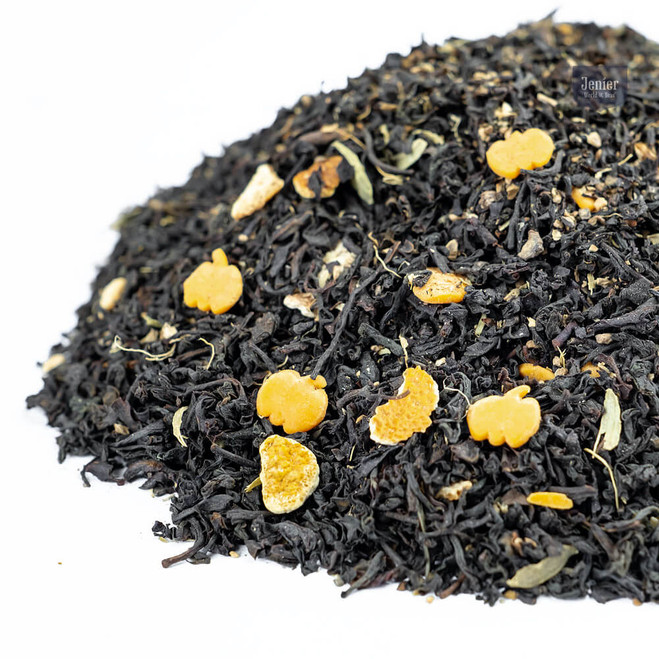-

Halloween Spice
£31.29 -

-

High Mountain Alishan Oolong Tea
£122.50 -

-

-

-

-

-

-

-

Jasmine Chai
£25.46 -

Java Santosa BOPS
£20.71
Shop our collection of Loose Leaf Teas by Type
Wholesale pricing applied to larger pack sizes (from 250g).
Shop our collection of loose teas. If you'd like to sample any teas, find out how you can order free samples: How to order Jenier tea samples.
Your Guide To Loose Leaf Teas By Type.
Your Guide To Loose Leaf Teas By Type.
White Tea
- Definition and origin: White tea is the least processed tea originating from China's Fujian province.
- Leaf, aroma, and taste profile: The leaves are delicate, with a light, floral aroma and a subtle, sweet taste.
- Common growing regions: Fujian and Yunnan provinces in China.
- Production process: The leaves are plucked and allowed to wither in the sun, preserving their natural flavour.
- Caffeine content: Low, making it a suitable choice for those sensitive to caffeine.
Green Tea
- Definition and origin: Green tea is unoxidised and has been consumed in China for thousands of years.
- Leaf, aroma, and taste profile: The leaves are green and can have a grassy, vegetal, or sweet taste, depending on the variety.
- Common growing regions: China, Japan, Kenya and Korea.
- Production process: The leaves are quickly steamed or pan-fired to prevent oxidation, preserving their green colour and fresh flavour.
- Caffeine content: Low to moderate.
Oolong Tea
- Definition and origin: Oolong tea is a partially oxidised tea originating from China's Fujian province.
- Leaf, aroma, and taste profile: The leaves can range from green to dark brown, with a floral, fruity, or creamy taste profile.
- Common growing regions: China and Taiwan.
- Production process: The leaves are withered, bruised, and partially oxidised before being fired.
- Caffeine content: Moderate.
Yellow Tea
- Definition and origin: Yellow tea is a rare and slightly oxidised tea primarily produced in China.
- Leaf, aroma, and taste profile: The leaves are yellowish-green, with a mild, sweet, and floral taste.
- Common growing regions: China's Sichuan, Anhui, and Hunan provinces.
- Production process: Similar to green tea, but with an additional step of "smothering" the leaves, allowing for a slight oxidation.
- Caffeine content: Low to moderate.
Black Tea
- Definition and origin: Black tea is fully oxidised, originating from China.
- Leaf, aroma, and taste profile: The leaves are dark brown to black, with a bold, robust, and sometimes malty taste.
- Common growing regions: China, India, Sri Lanka, and Kenya.
- Production process: The leaves are withered, rolled, fully oxidised, and fired.
- Caffeine content: Moderate to high.
Pu-Erh Tea
- Definition and origin: Pu-Erh tea is a fermented and aged tea originating from China's Yunnan province.
- Leaf, aroma, and taste profile: The leaves are dark and earthy, with a unique, complex, and sometimes musty taste.
- Common growing regions: Yunnan province in China.
- The production process for raw and cooked Pu-Erh: Raw Pu-Erh is sun-dried and aged, while cooked Pu-Erh undergoes an accelerated fermentation process.
- Caffeine content: Moderate to high.
Matcha
- Definition and origin: Matcha is a powdered green tea originating from Japan
- Leaf, aroma, and taste profile: The powdered leaves are bright green in colour with an earthy aroma and smooth, sweet flavour.
- Common growing regions: Japan.
- Production process: Raw Matcha is ground down into a fine powder using a stone mill or electric grinder
- Caffeine content: Moderate to high
Loose-leaf tea offers diverse flavours, aromas, and potential health benefits. Choosing high-quality tea is essential for the best taste and experience. We encourage you to explore different varieties and find your personal favourites. Enjoy your journey into the world of loose-leaf tea!
Loose Leaf Tea FAQ
We've compiled answers to the top 10 most frequently asked questions to help you understand and enjoy this popular beverage better.
What is loose leaf tea?
Loose-leaf tea is a tea that is sold in bulk without being pre-packaged in tea bags. The tea leaves are typically larger and more whole than those found in tea bags, allowing them to unfurl and release more flavour during the brewing process.
How is loose leaf tea different from tea bags?
Loose-leaf tea is generally considered to be of higher quality than bagged tea, as it typically contains larger, whole leaves that retain more of their natural oils and flavour. In contrast, tea bags often contain smaller, broken leaves and tea dust, which can result in a less flavourful and more bitter brew. Additionally, using loose-leaf tea allows for greater control over the brewing process, such as adjusting the amount of tea used or the steeping time.
What are the different types of loose leaf tea?
There are several main types of loose-leaf tea, which can be categorised based on the processing methods used:
- Green tea: Minimally processed and not oxidized, green tea has a fresh, grassy flavour and is rich in antioxidants.
- Black tea: Fully oxidised, black tea has a robust, bold flavour and a higher caffeine content compared to green tea.
- Oolong tea: Partially oxidised, oolong tea falls between green and black tea in terms of flavour, colour, and caffeine content.
- White tea: The least processed of all tea types, white tea is delicate in flavour and has the lowest caffeine content.
- Pu-erh tea: Aged and fermented, pu-erh tea has a unique, earthy flavour and can be found in both raw (sheng) and ripe (shou) varieties.
How do I store loose leaf tea?
To maintain freshness and flavour, loose-leaf tea should be stored in an airtight container, away from light, heat, and moisture. It's also important to keep tea away from strong odours, as it can easily absorb them. A cool, dark pantry or cupboard is an ideal storage location.
How do I brew loose leaf tea?
To brew loose-leaf tea, you'll need a teapot or infuser, hot water, and your choice of tea. Follow these steps for a perfect cup:
- Measure the appropriate amount of tea leaves (usually 1 teaspoon per 250 ml of water).
- Heat water to the recommended temperature for your tea type (e.g., 175°F for green tea, 212°F for black tea).
- Place the tea leaves in your teapot or infuser and pour the hot water over them.
- Allow the tea to steep for the recommended time (e.g., 2-4 minutes for green tea, 3-7 minutes for black tea).
- Remove the tea leaves and enjoy your freshly brewed cup of loose-leaf tea.
Can I reuse loose leaf tea?
Yes, a loose-leaf tea can often be steeped multiple times, with each infusion revealing new flavours and nuances. The number of times a tea can be re-steeped will depend on the type and quality of the tea, as well as personal taste preferences. To re-steep tea, follow the brewing process again, adding more time to the steeping duration for each subsequent infusion.
What are the health benefits of loose leaf tea?
Loose leaf tea is rich in antioxidants, vitamins, and minerals that can provide a range of health benefits, including:
- Boosting the immune system
- Reducing inflammation
- Improving heart health
- Aiding in weight management
- Enhancing mental alertness
The specific health benefits will vary depending on the type of tea, with green and white teas generally considered to have the highest levels of antioxidants.
Is loose leaf tea better for the environment?
Loose-leaf tea is generally more environmentally friendly than bagged tea, as it produces less waste due to the absence of tea bags, wrappers, and packaging materials. Additionally, many tea bags contain non-biodegradable materials like plastic, which can contribute to pollution and harm marine life. Choosing loose-leaf tea can help reduce waste and minimize your environmental impact.
Where can I buy loose leaf tea?
Loose-leaf tea can be purchased at speciality tea shops, health food stores, and online retailers. When selecting a tea, look for high-quality, ethically sourced options prioritising sustainable farming practices and fair labour conditions.
How much loose leaf tea should I use per cup?
A general guideline is to use 1 teaspoon of loose-leaf tea per 250 ml of water. However, this can vary depending on the type of tea and personal taste preferences. Some teas, like oolongs and pu-erhs, may require more leaves, while others, like green and white teas, may require less. Experiment with different amounts to find the perfect balance for your taste buds.
